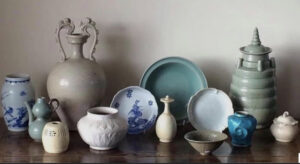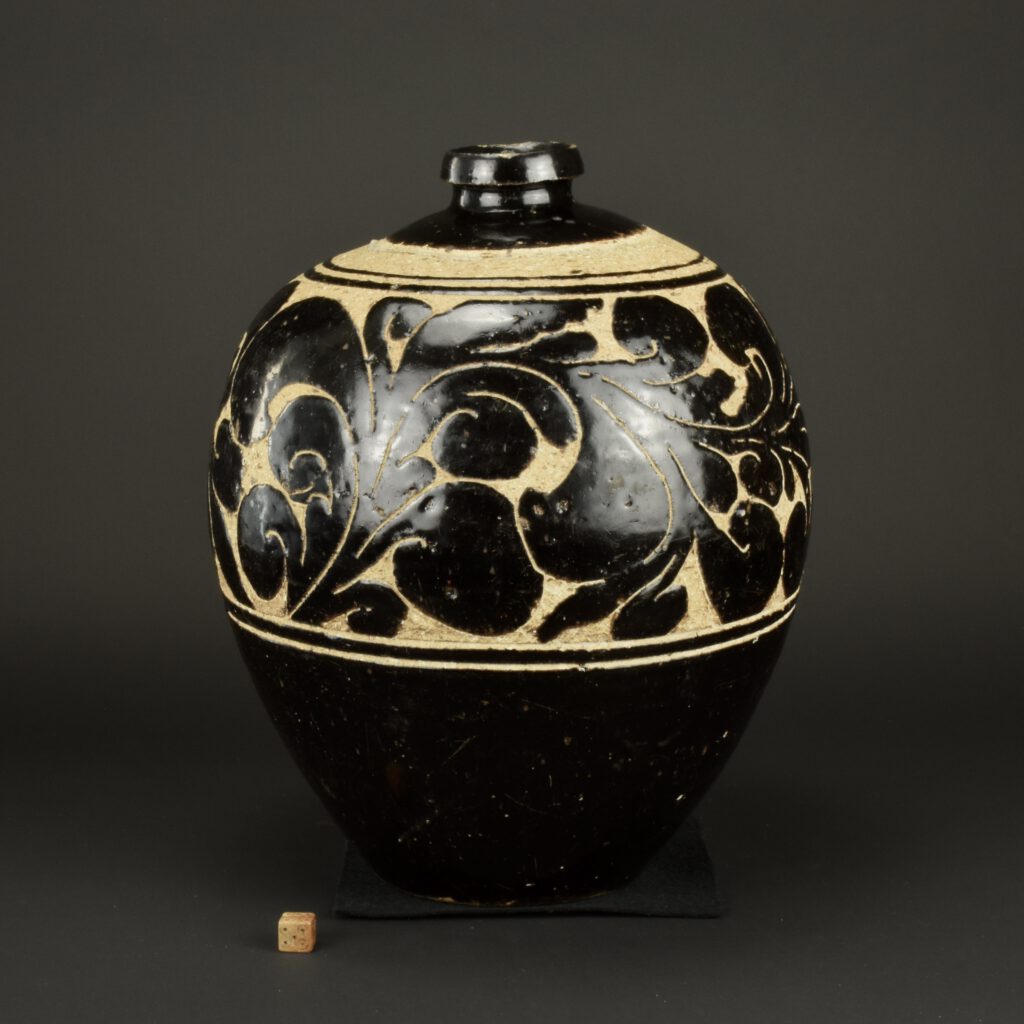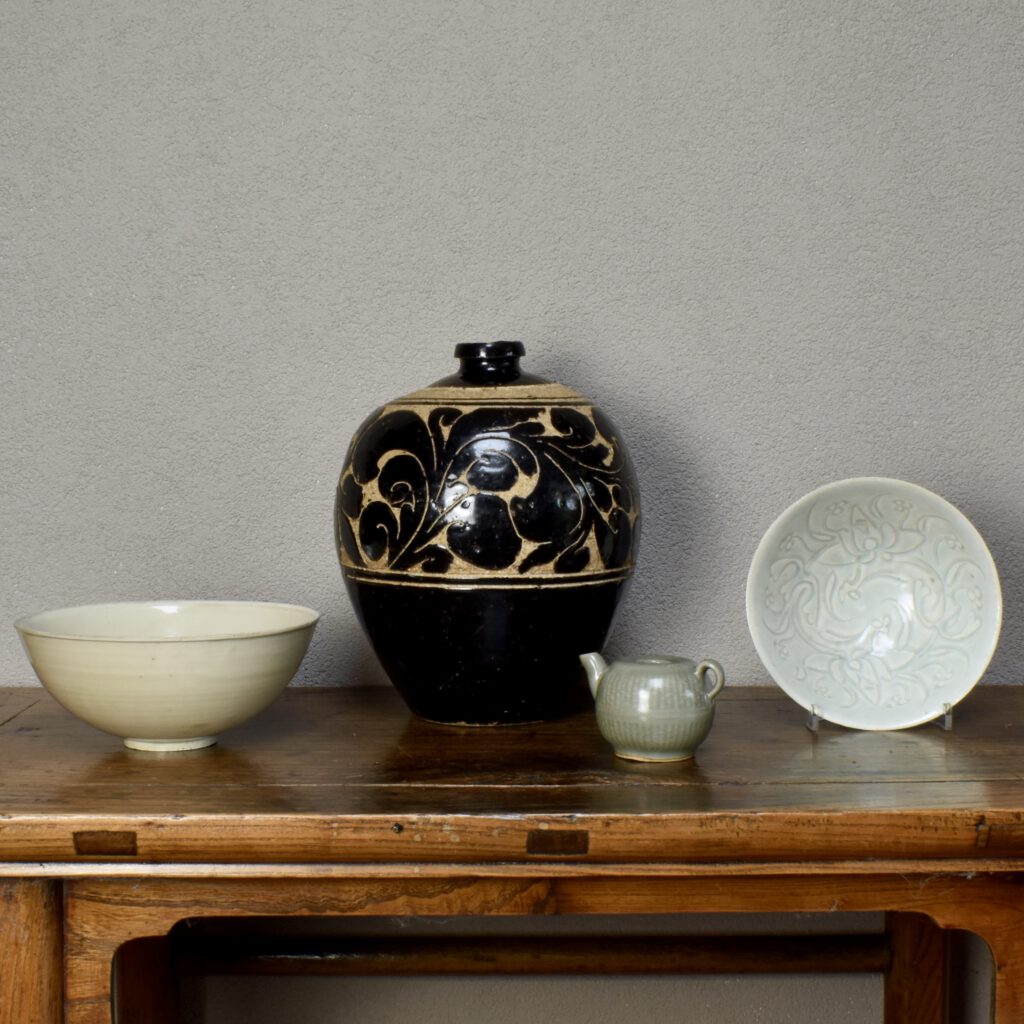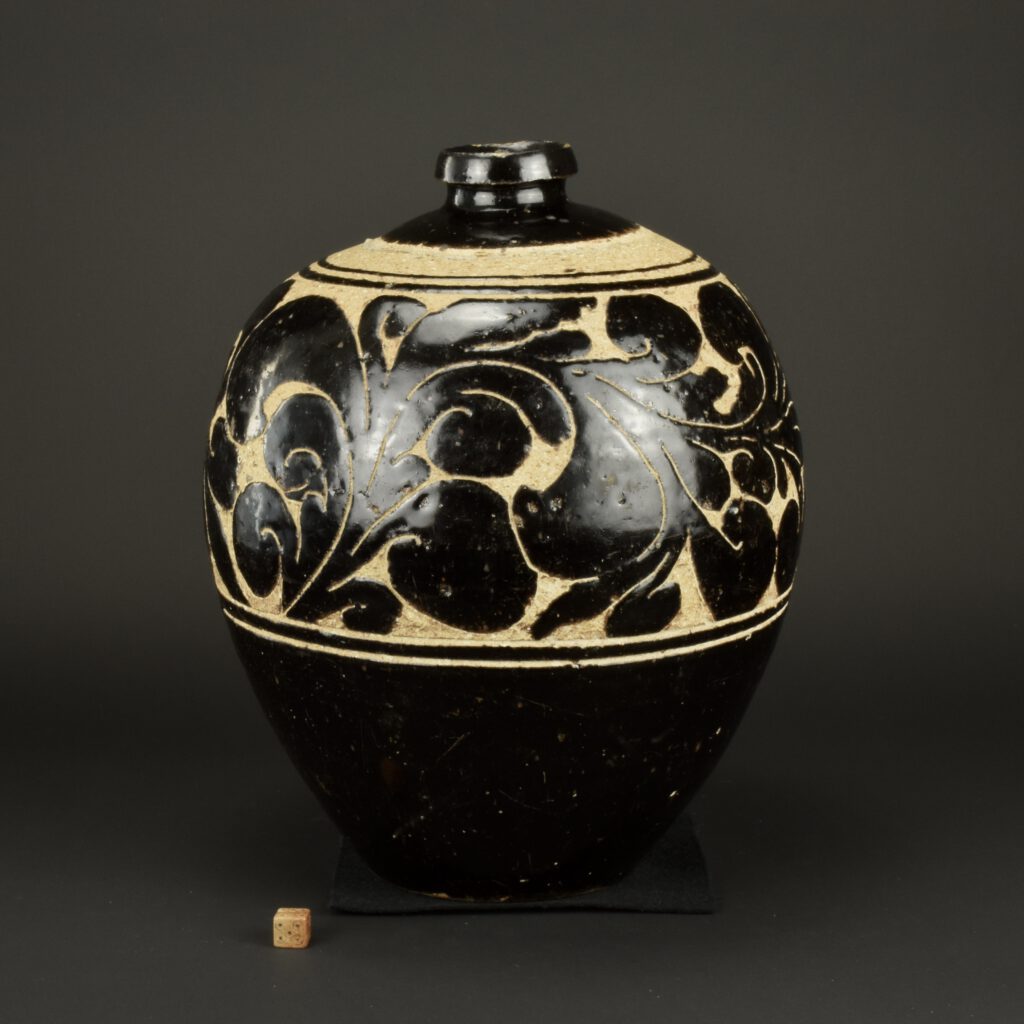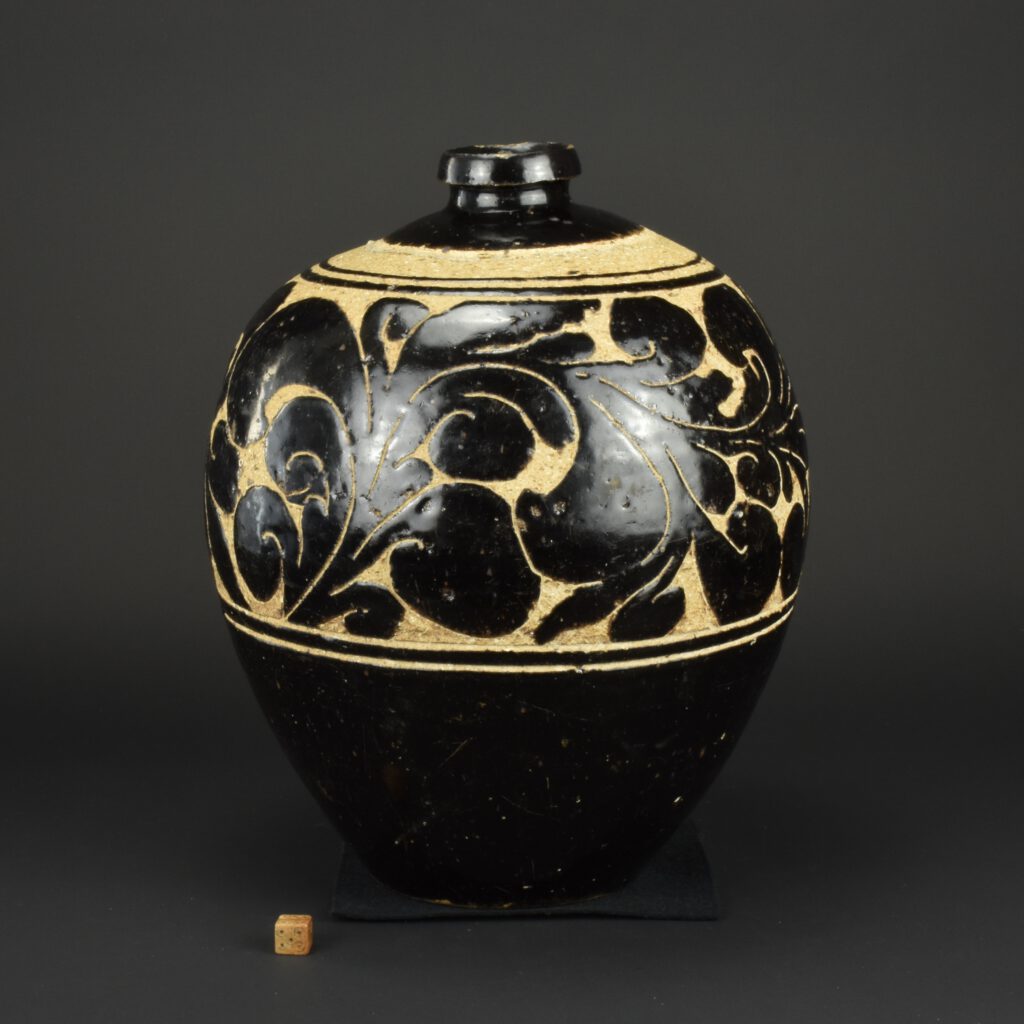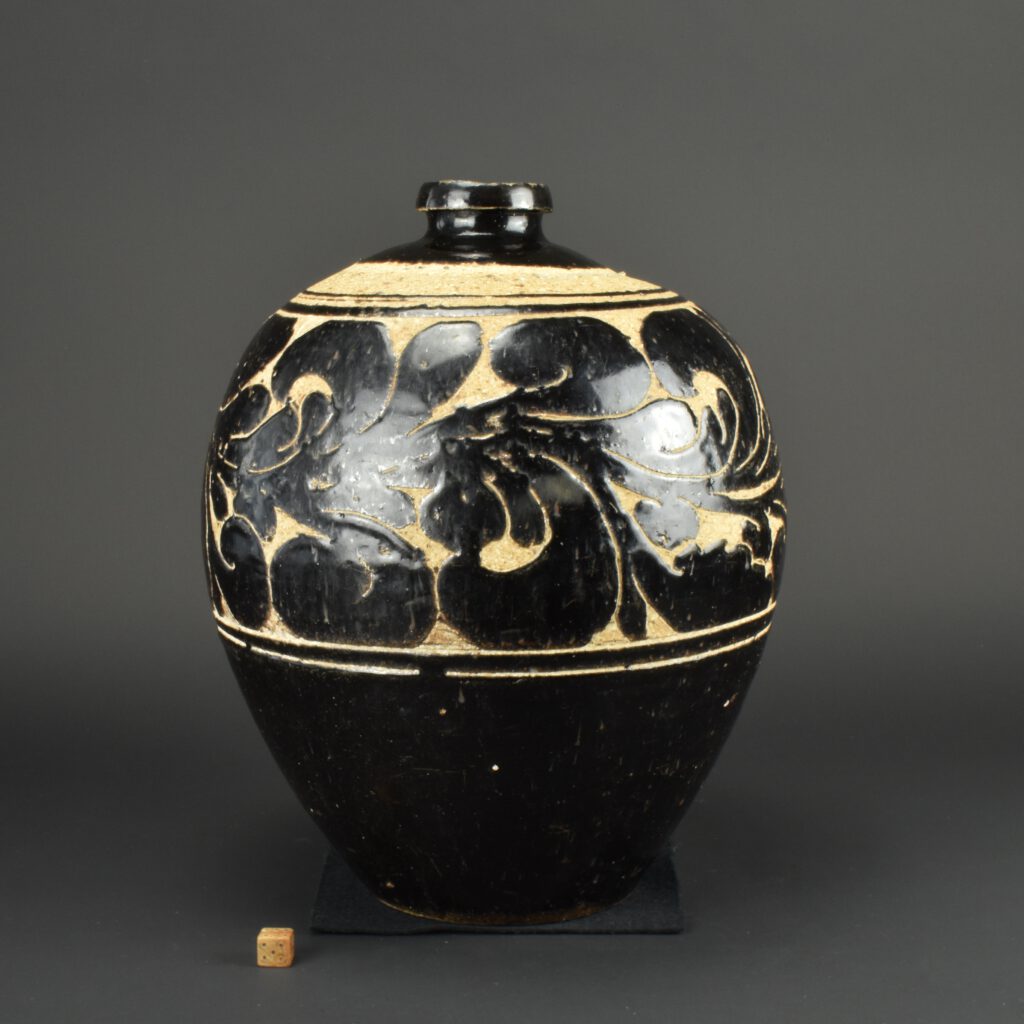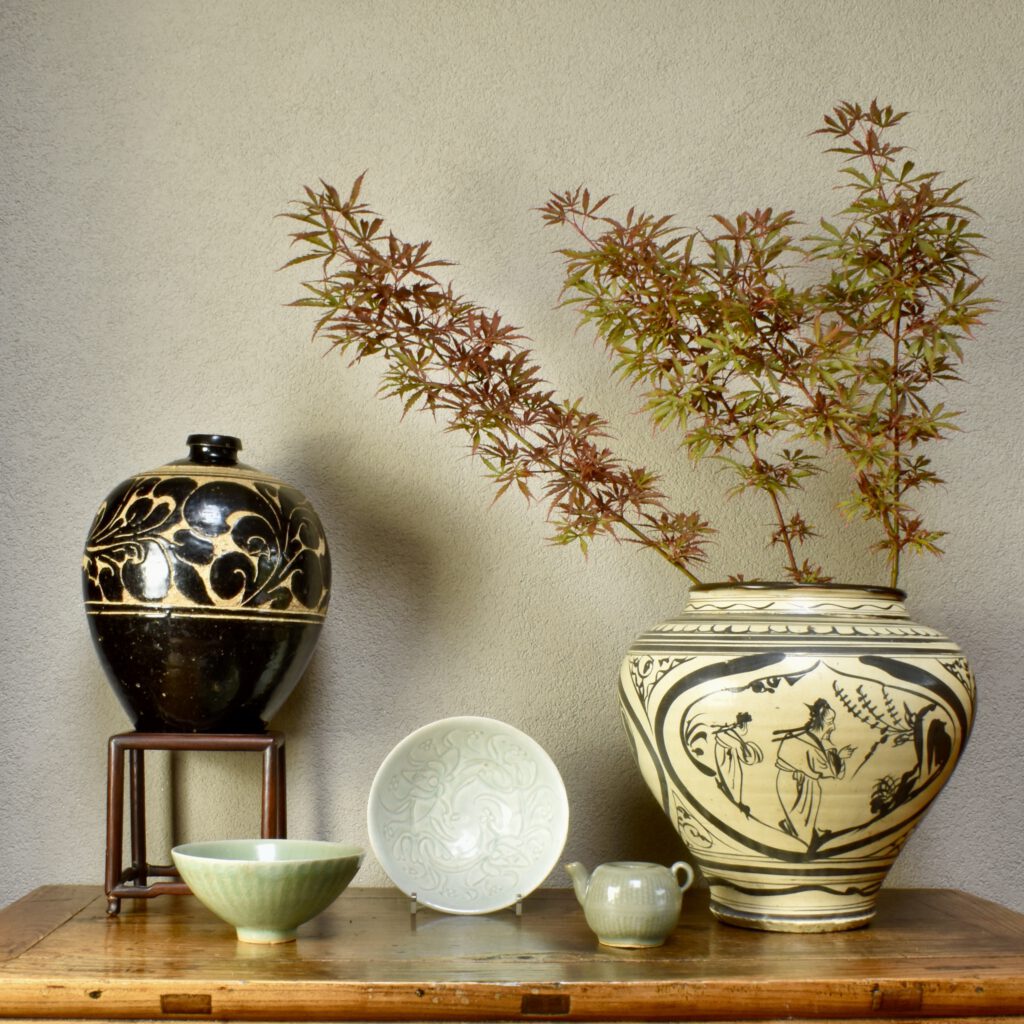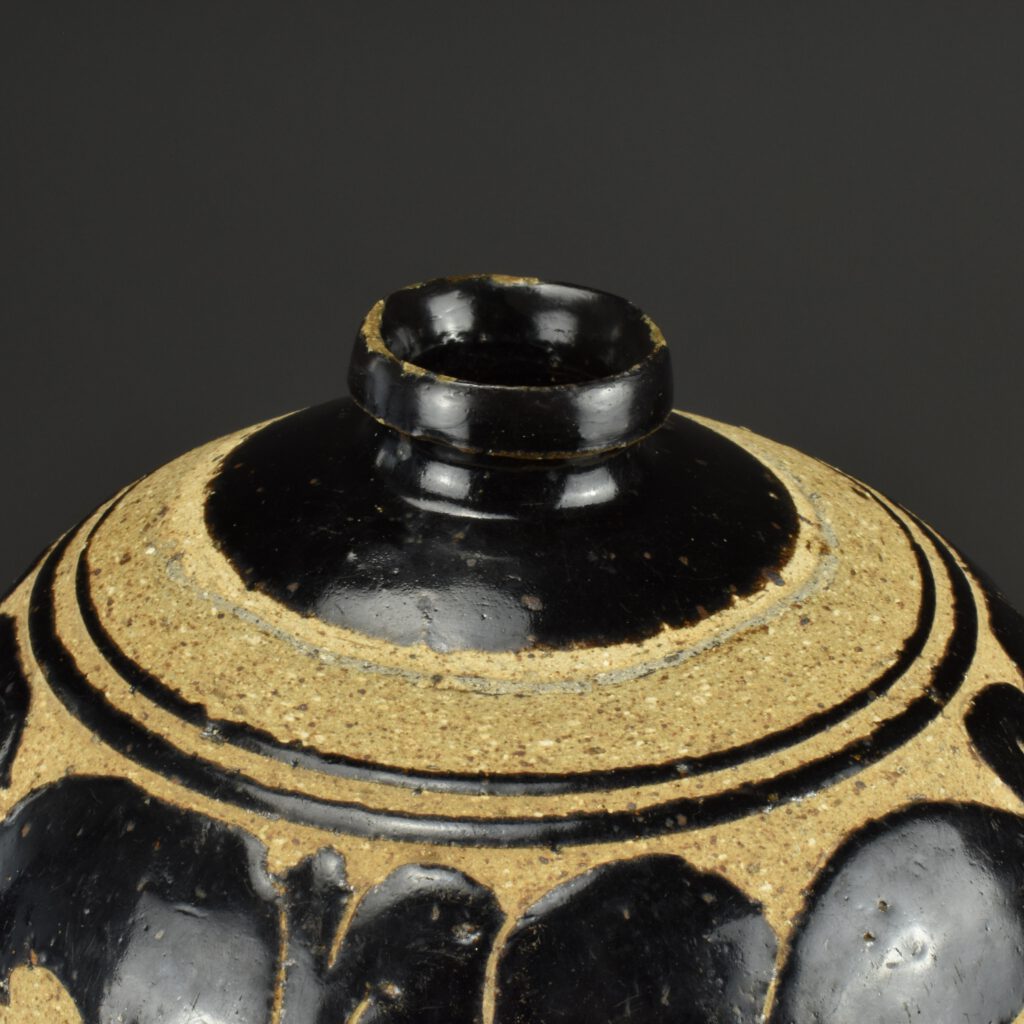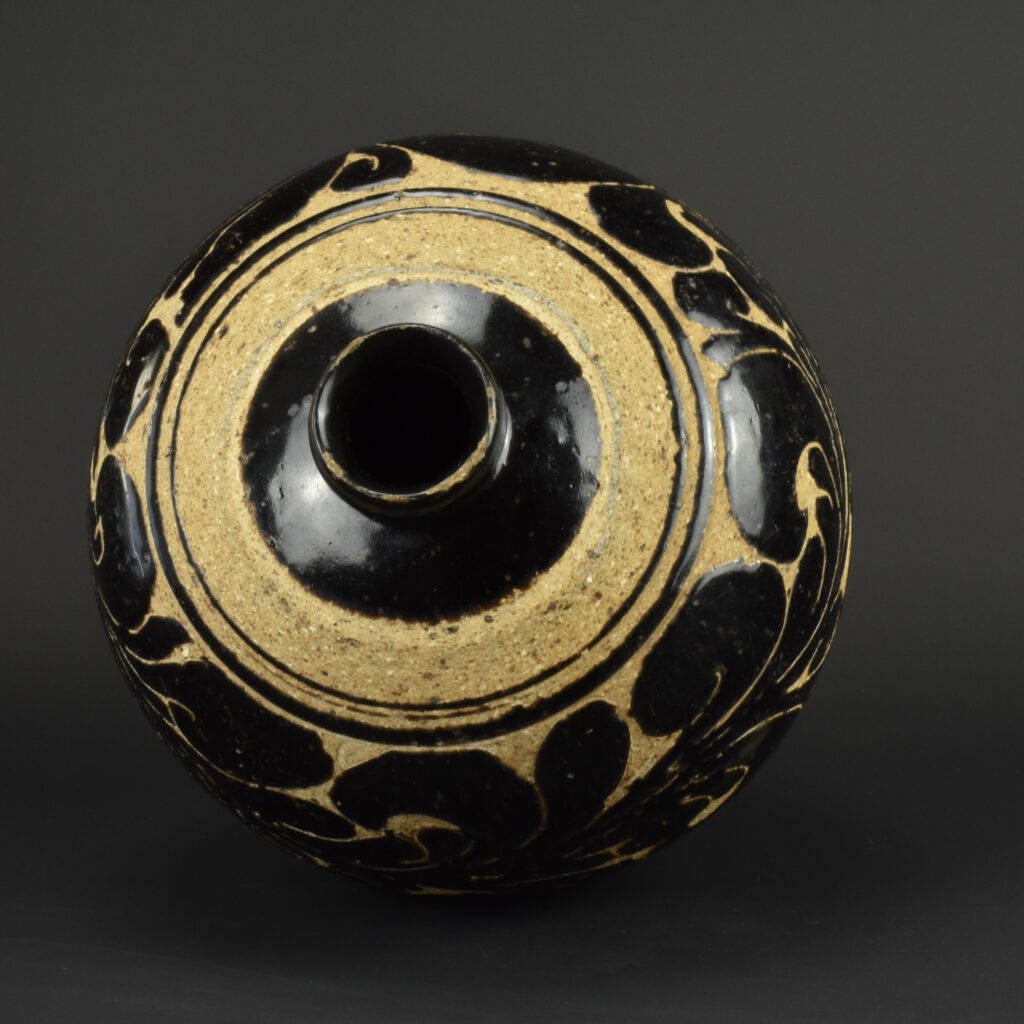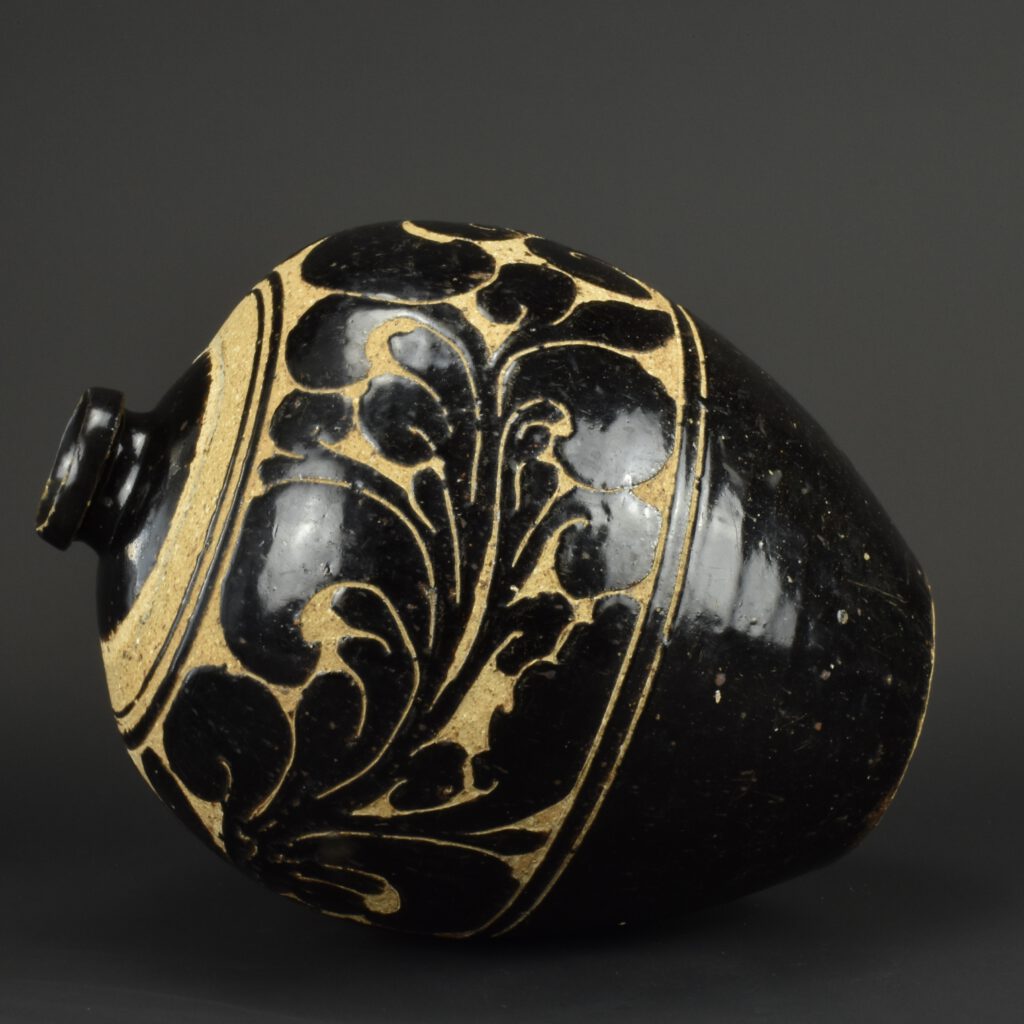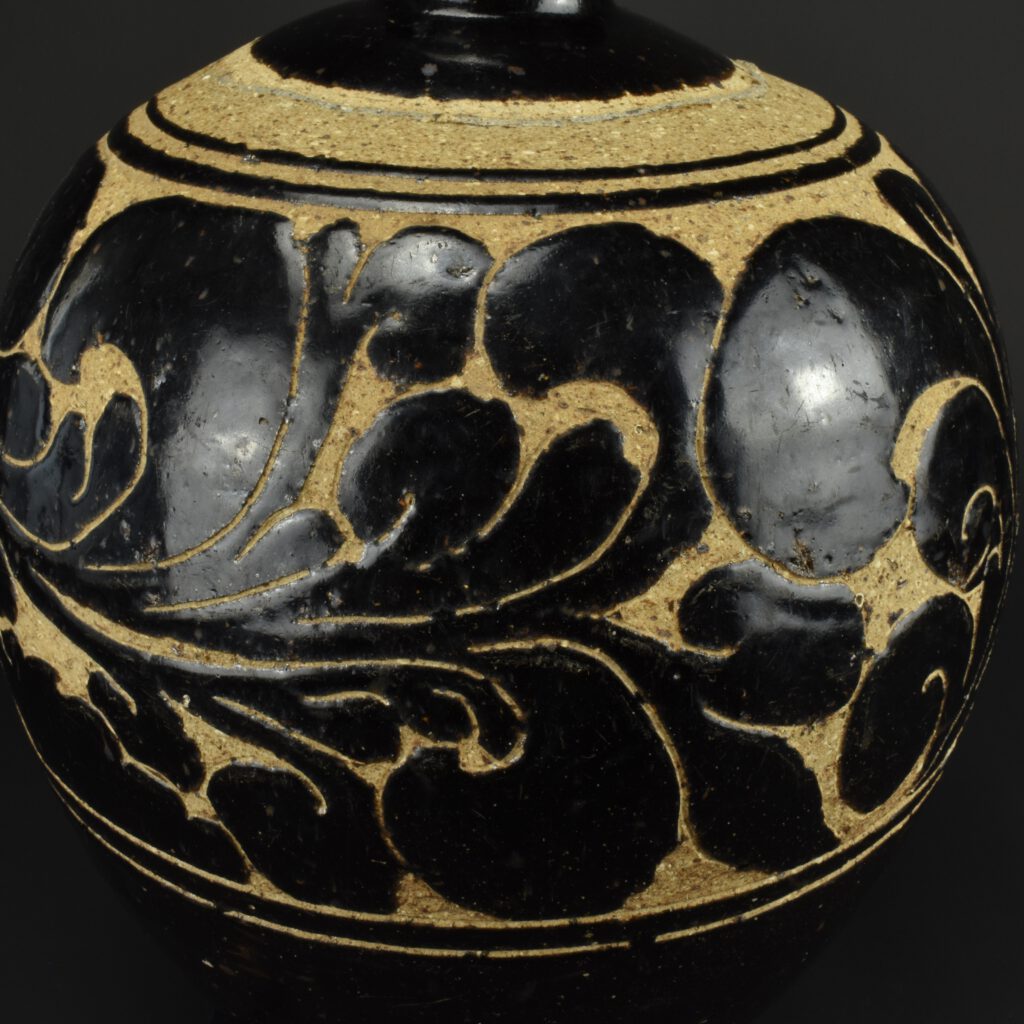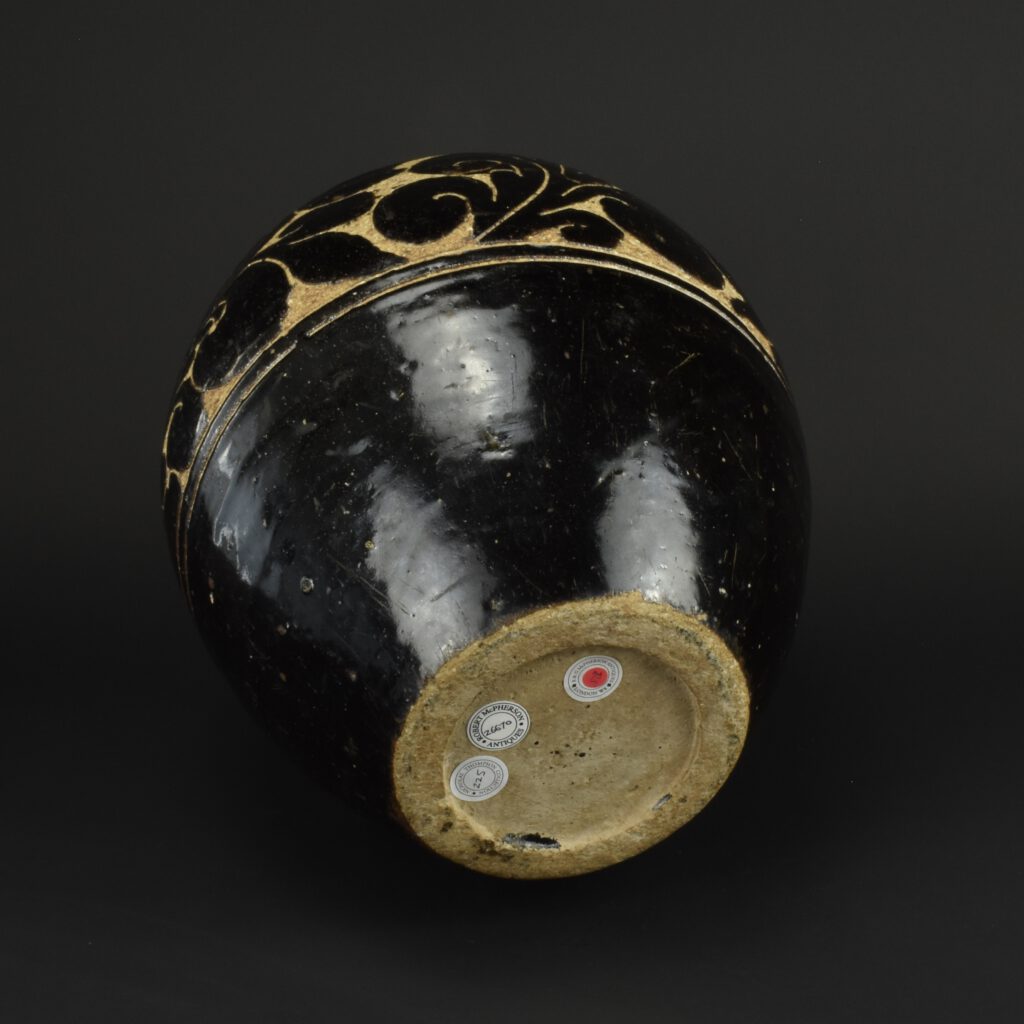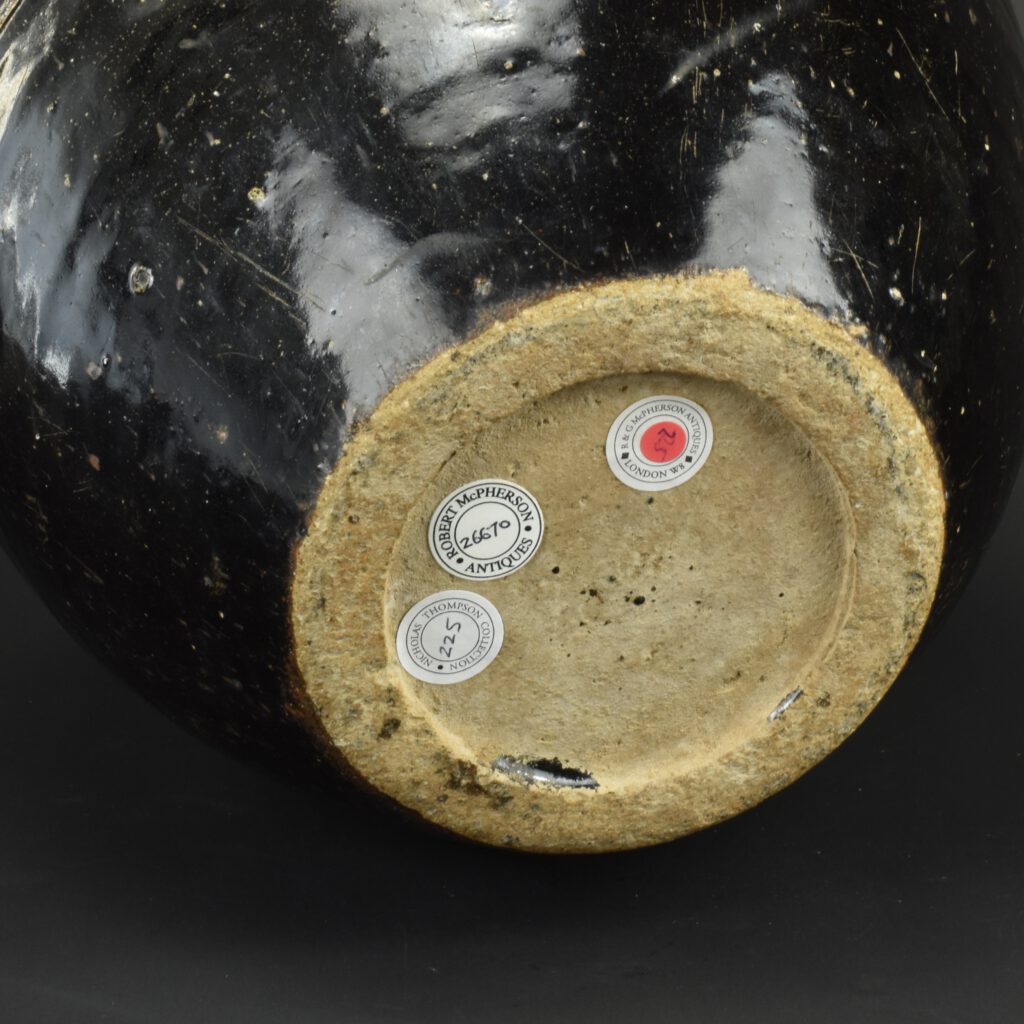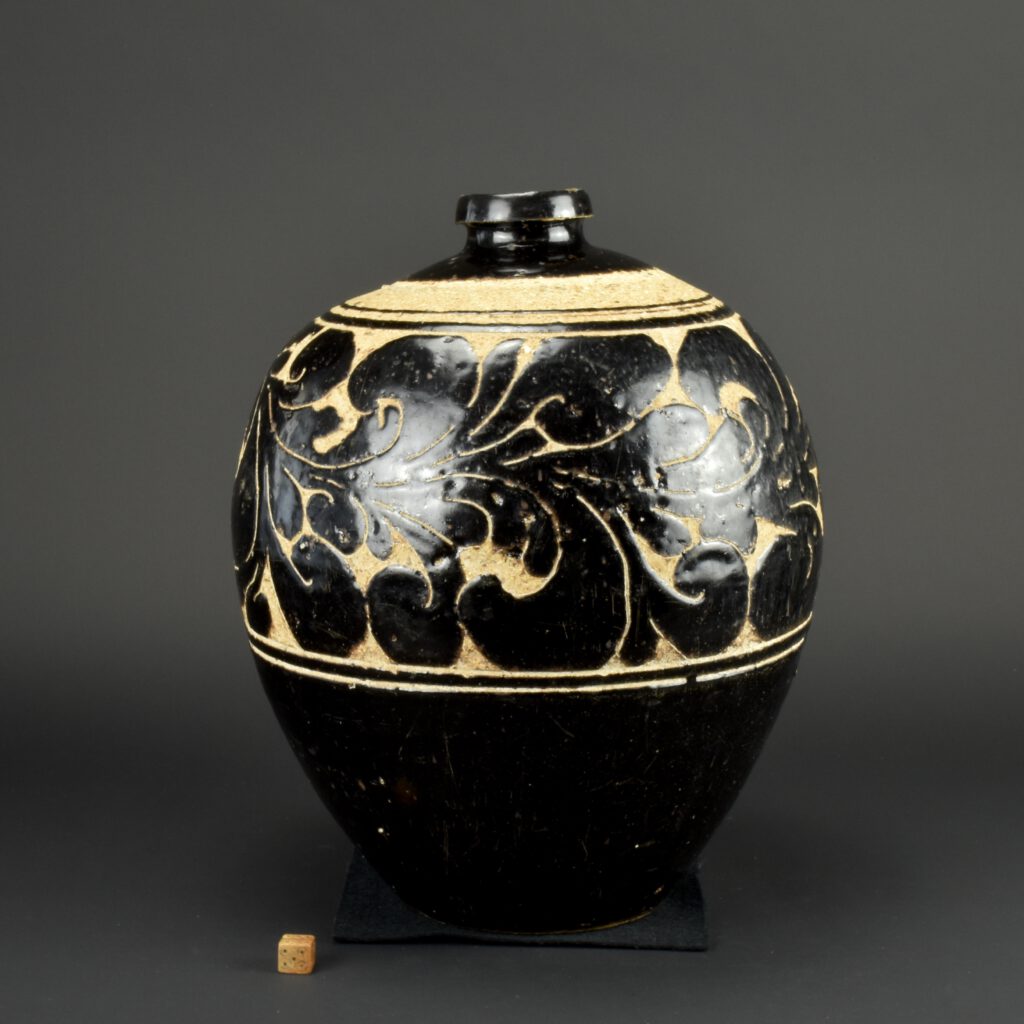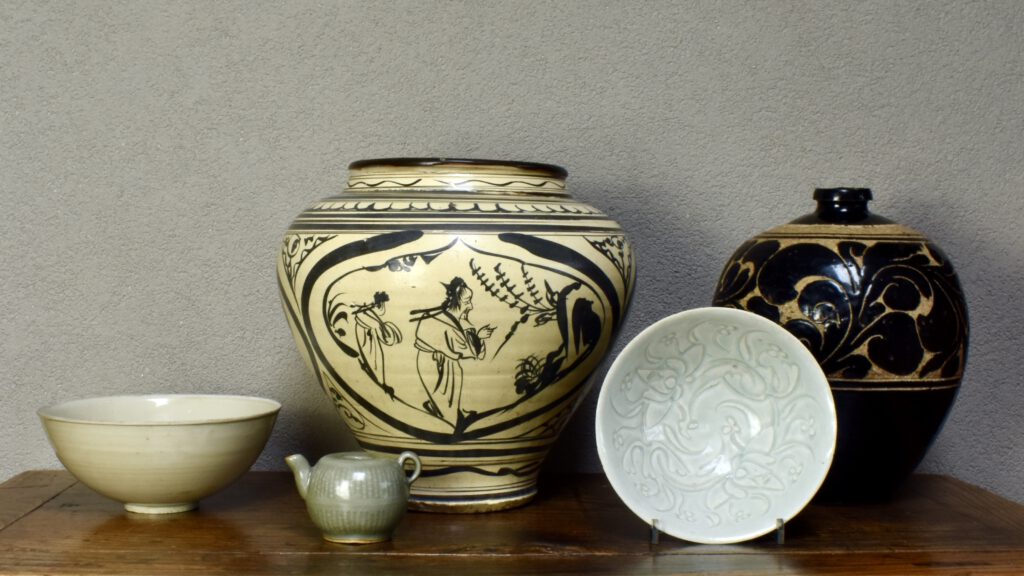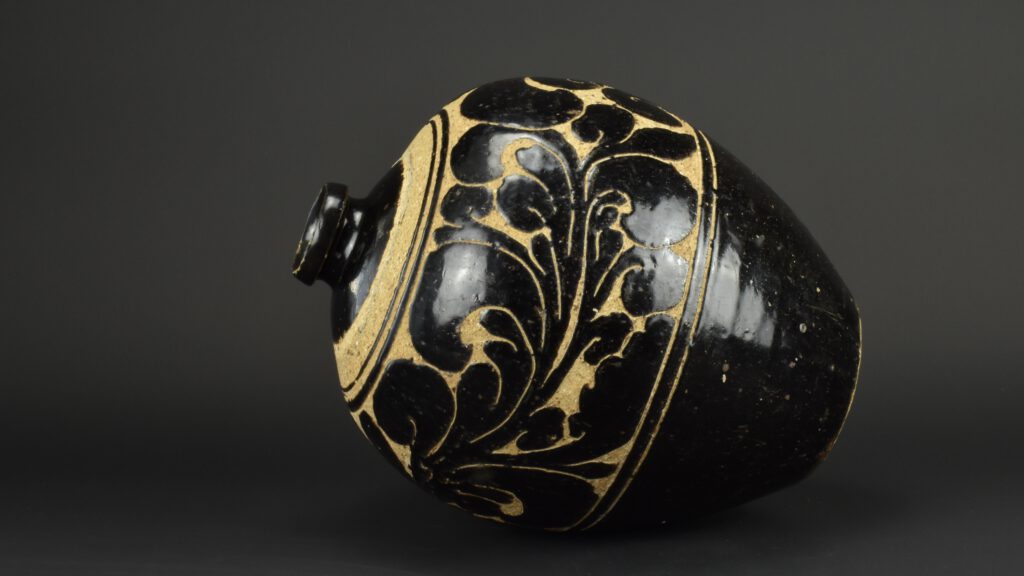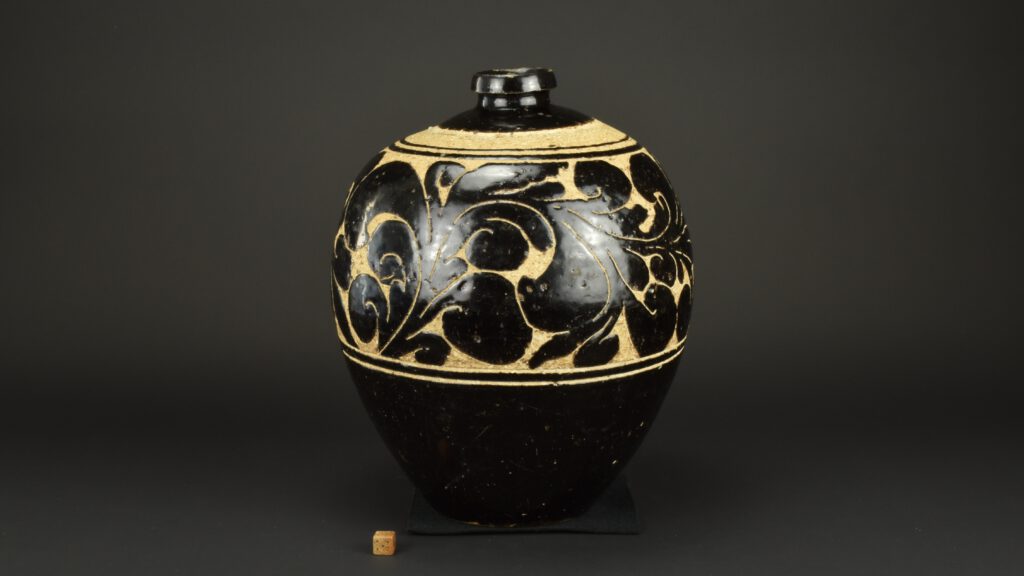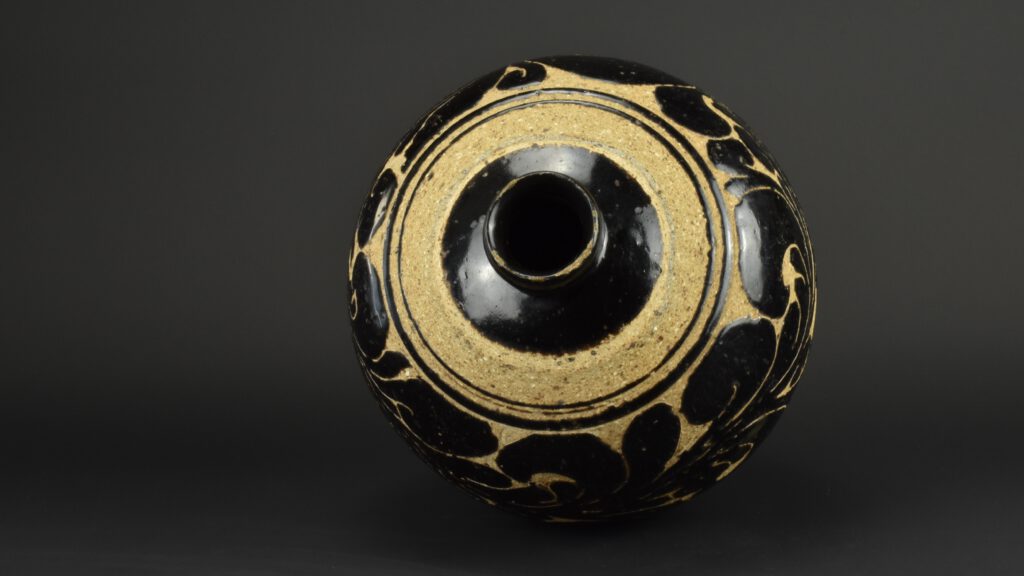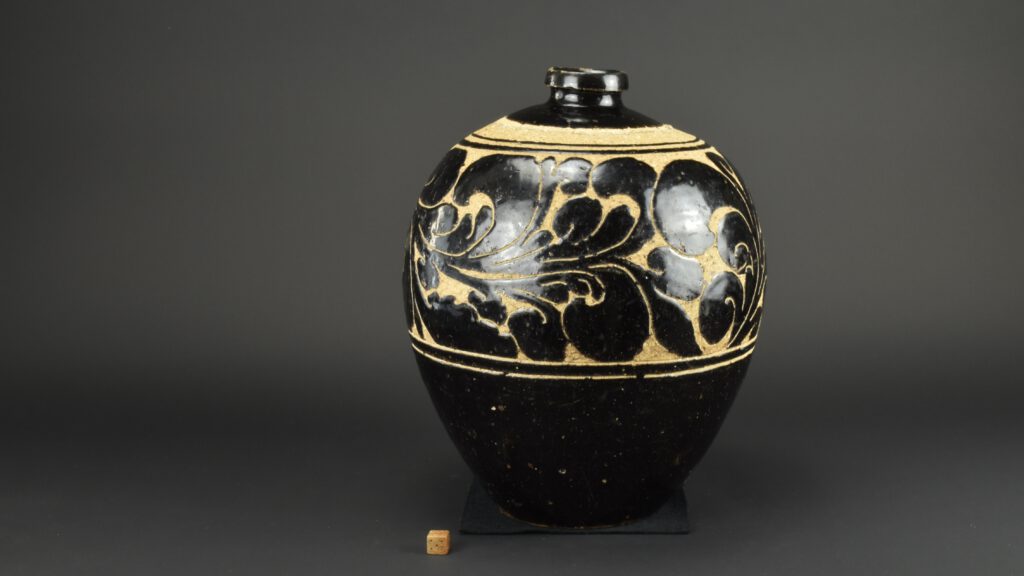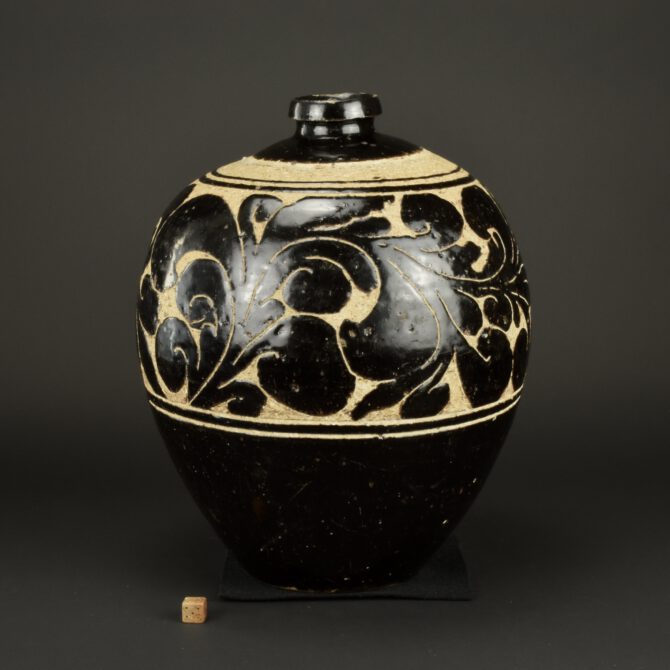
A Large 13th Century Northern Black Glazed Sgraffiato Jar
A Large 13th Century Northern Black Glazed Sgraffiato Jar, Jin, Xixia or Yuan 13th Century, from North or North West China. From the collection of Nicholas de la Mare Thompson (1928-2010). This very heavy bottle is made of a rough clay containing fragments of grit and sand, or possibly grog (sometimes called chamotte, made from pot sherds ground up). Grog is used by potters to give a rustic appearance, but it is also used to stop, it also helps stop cracking by reducing plasticity, as well as reducing the chances of thermal shock which can lead to the pot not surviving the firing process. The grit is brown, cream and off-white. It was dipped in a thick black iron-rich glaze. Before the glaze was completely dry, it was cut into with a sharp implement, exposing the rough stoneware body. The edges of the glaze are not hard like cut glass, as they would have been if the glaze had been fired. The edges are slightly soft, the trick was to cut through at just the right time, too early and the glaze would have run, too late and the blade might have dragged the glaze. The design is of stylised scrolling leaves. The upper shoulder has a wide band wiped clear of glaze, the upper part of this band is slightly paler, and there is a very thin scar of clay adhering to about 70% of the surface. Above the scar, near the glazed top, the clay has fired a paler colour. This is because the clay was protected from the oxidizing effect of the firing. It is possible that something else was fired on top. The foot is broad and shallow, this was created by cutting into the base to leave the foot on the same level as the bottle. The sharp, angled top is typical of this type of stoneware made at this period. It might have had a wooden stopper, perhaps covered with fabric which could be secured with string below the overhanging part of the top.
SOLD
See Below For More Photographs and Information
- Condition
- Two restored large chips to the rim,some scratches and ware, slightly warped.
- Size
- Height approximately 30cm.
- Provenance
- R&G McPherson Antiques, 21st of February 2005. From the collection of Nicholas de la Mare Thompson (1928-2010).
- Stock number
- 26670
- References
- See 'Information' below the Photograph Gallery. For a related jar see : Chinese Ceramics from the Meiyintang Collection Volume 1 (Regina Krahl, Azimuth Editions, 1994) Page 251 plate 455.
Information
A Large Carved Yuan Dynasty (1279-1368).
Robert McPherson Antiques - Sold Archive - 27166.
A Large Carved Yuan Dynasty (1279-1368) Black Glazed Sgraffito Stoneware Guan of Cizhou Type, North China, Probably Shanxi Province. Jars, like the present example were for storing wine, so it is referred to as a Guan. A very similar jar on display in the British Museum (Location On display (G33/dc33a/s3) (G33/dc33a/s3). It was Found/Acquired in Shanxi province in 1911, and the museum tentatively attribute its production to that province. Below is a photograph of the British Museum jar on display in the Sir Joseph Hotung Gallery. This imposing heavy Yuan jar is constructed from a stoneware which is rough and is gritty, this grit varies, it is full of different tones and colours from white, very pale yellow to brown and black. It was then dipped in a thick dark brown iron-rich glaze, this thick brown becomes black in appearance due to the density of the glaze. Before the glaze was completely dry, it was cut into with a sharp implement, exposing the rough stoneware body. The edges of the glaze are not hard like cut glass, as they would have been if the glaze had been fired. The edges are slightly soft, the trick was to cut through at just the right time, too early and the glaze would have run, too late and the blade might have dragged the glaze.The design is of a stylised scrolling palmate leaf in two mirrored registers. There are small areas where the glaze has run, on a large jar like this that is almost inevitable. Everything about this Guan is strong and solid, from the proportions to size and materials used.
- References : A very similar Yuan or early Ming stoneware jar is on display at the British Museum, Museum number 1911,1025.11. For a similar smaller jar with sgraffito floral designs unearthed in Xuanhua district, Zhangjiakou city in the Hebei Institute of Cultural Relics see see Zhang Bai (ed), Complete Collection of Ceramic Art Unearthed in China, volume 3, Hebei, 中國出土瓷器全,Beijing 2008, p. 149
-
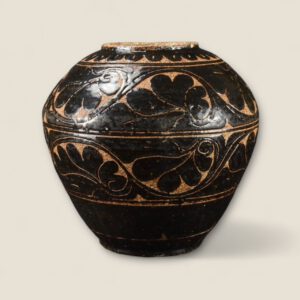
A Very Large Carved Yuan Black Glazed Stoneware Jar - Robert McPherson Antiques - 27166
British Museum, Sir Joseph Hotung Gallery.
A very similar Yuan or early Ming stoneware Guan. I took this photograph in the gallery recently.
Museum number 1911,1025.11.
https://www.britishmuseum.org/collection/object/A_1911-1025-11
Curator's comments
For a similar smaller jar with sgraffito floral designs unearthed in Xuanhua district, Zhangjiakou city in the Hebei Institute of Cultural Relics.
See Zhang Bai (ed), Complete Collection of Ceramic Art Unearthed in China, volume 3, Hebei, 中國出土瓷器全,Beijing 2008, p. 149
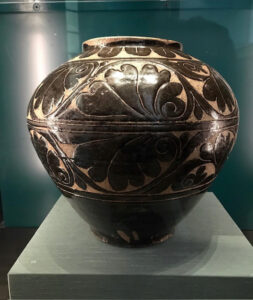
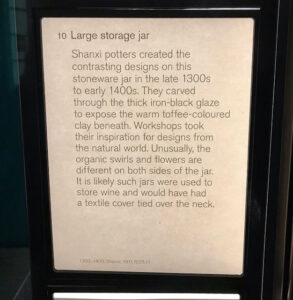
A Related Sgraffiato Jar Xixia or Jin Jar
Robert McPherson Antiques - Sold Archive 26073.
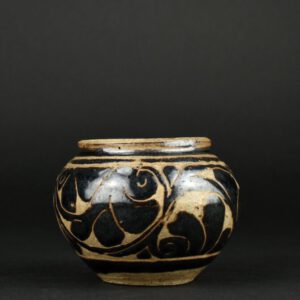
Xixia 1032 -1227 or Jin Dynasy 1115 -1234
A Fine Xixia (1032-1227) or Jin (1115-1234) small Sgraffiato Stoneware Jar, North or North West China. Made of fine stoneware which has been dipped in black-brown glaze and then when the glaze was in the process of drying it has been carved with stylised foliage. The body can’t have been fired as the edges of the carved glaze show tool marks that incise the stoneware body. A carved small jar of this type is illustrated in Chinese Ceramics from the Meiyintang Collection, Volume One (Regina Krahl, Azimuth Editions 1994. ISBN 1-8985592-02-0) page 250, plate 453.
Condition
In perfect condition (lacking cover).
Size
Height 7.3 cm (3 inches).
Provenance
From the Solk collection (Netherlands) purchased from Dries and Diana Blitz on August 26th 2004 for €3,350. A photocopy of the original invoice accompanies this jar.
Stock number
26073
Cizhou Ware :
A freedom of expression exists in Cizhou ware that is unparalleled by other Song dynasty (960-1279) ceramics. This was a direct result of not being under the control of the court; consequently, the liberty to explore and experiment created an innovative range of designs full of flavour and life unique to Cizhou ware. The utilization of enamelled decorations in tones of vivid reds, yellows, and greens on occasional Cizhou pieces placed it centuries ahead of its time as this was not kosher for early court wares. The ware also displays an amazing dexterity in the sketchily incised patterns which have such a sense of carefree abandon that they appear impressionistic. Today, Cizhou ware is prized for its natural appearance which often reveals the potter’s process from the wheel’s rings, to the inner spur marks, to the unevenly glazed base.
The white stonewares of the Tang dynasty (618-906) produced two extremely influential wares; the first, Ding ware, became the official ware while the second, Cizhou, became the “popular ware” among the varying classes. It was Cizhou wares utilization by society that assured its continuance during political and dynastic changes which extinguished other Song wares; consequently, Cizhou ware is still produced today though the wares created during the Song dynasty are considered to possess an unrivalled spirit. Since Cizhou ware embodies a diverse range of wares not confined to a specific location, kiln complex, or style it is difficult to precisely define its characteristics.
The name Cizhou originated from the ancient area of Cizhou, encompassing a broad arc across China, which was first recorded during the Sui dynasty (581-618). However, the location constantly shifted and though the area of Cizhou is mentioned in the Tang dynasty (618-906) and Five Dynasties (906-960), each referred to an altered location.During the Song, Jin (1125-1234), Yuan (1279-1368), and partly into the Ming dynasties (1368-1644) the kiln areas of Cizhou were primarily concentrated in the northern provinces of Hebei, Henan, and Shaanxi. (By Mindy MacDonald).
Nicholas de la Mare Thompson (1928-2010).

Nicholas de la Mare Thompson (1928-2010), the grandson of the author Walter de la Mare spent his career in publishing. He started at Nesbit where he was editor of the Janet and John series of children’s books but not all of his career was so safe. He wrestled with W.H. Smith over the content of Madonna’s raunchy Sex book on behalf of Paul Hamlyn’s Octopus Group and defeated Margaret Thatcher over Spycatcher. He could not bare dogma or hypocrisy. It was hardly surprising that as a committee member of the O.C.S. he had his own ideas. He read and could recite great swaths of the articles of the Society, he used this not to attack but to stimulate debate. He approached the Society in the same way as he approached his understanding of Chinese ceramics, by stripping it down and starting again using clear empirical thinking. He was very concerned the Society was open to all and was run for the benefit of all members. Nicholas came from a family of collectors, his love of oriental ceramics was broad but his focus was on early monochromes, especially those from the Song dynasty. He bought what he loved, what he thought had merit, not what was said to be good, and certainly not anything because it was fashionable. He didn’t have a stamp collectors approach, filling in the gaps of pre-existing ordered collection, rather he would react to an object, feeling it was right for his collection. Sometimes he wasn’t sure if it was right for his collection or not. He would then “borrow” pieces and live with them, other times he would ask his wife Caroline, who’s eye he trusted, if he should keep the piece or not. He was amused because I was often able to know if he would keep a piece before he did.
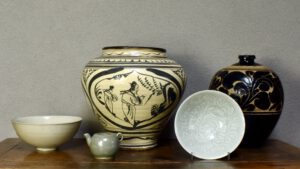
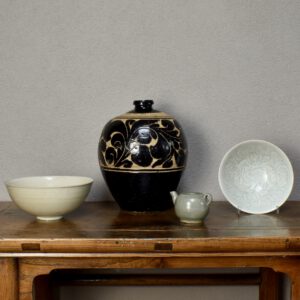
We discussed “pots” endlessly, he loved to talk about ceramics with a wide variety of people, and enjoyed the company of others on O.C.S. trips as well as in discussion groups or anywhere else. Later on he combined his love of Chinese ceramics with his love of books by extending his library to include rare early books, he used these to trace the development of collecting and scholarship in the 19th and early 20th century. He was fascinated by earlier scholarship, what was not understood but also what they understood and we have lost. He was always reading and wanted to know more right up to the end, he didn’t see impending death as a barrier to knowledge or indeed collecting. The week before he died he questioned, if only for a second, whether it was too late to buy another pot for the collection. He concluded it was not, he was a true collector. Nicolas died on the 25th of April 2010 at the age of 82 after living with cancer for two years. He leaves behind his energetically supportive wife Caroline and his three children. He was a kind, gentle and incredibly civilised man with a very sharp mind and dry sense of humour, he was passionate about the Society, its aims and its members. He was an incredibly supportive and thoughtful friend and is very much missed .
